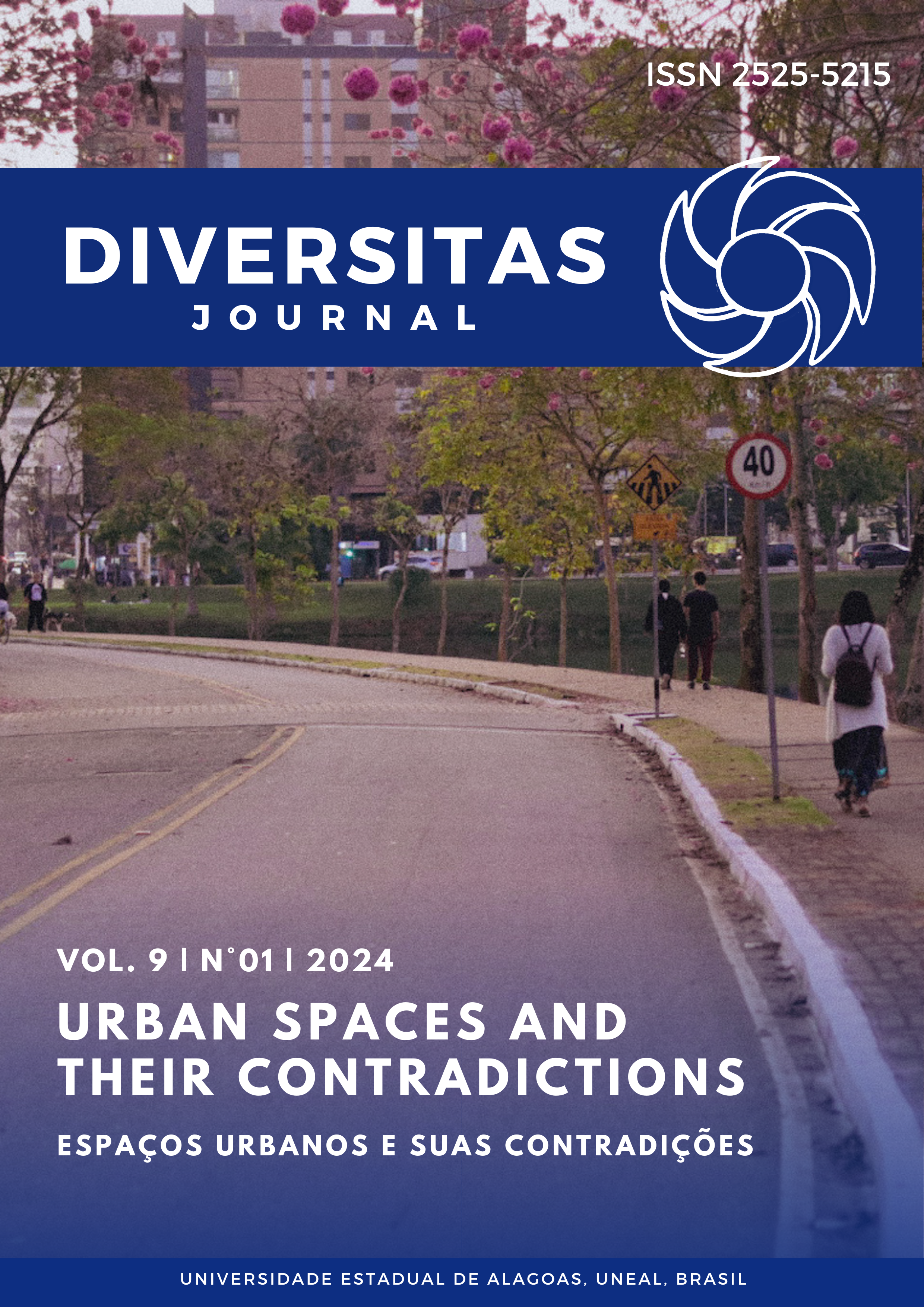Health conditions and contextual inequalities in quilombola communities in the covid-19 pandemic
DOI:
https://doi.org/10.48017/dj.v9i1.2634Keywords:
Covid-19., Vulnerable Populations, African Continental Ancestry GroupAbstract
Objective: To analyze vulnerabilities and health conditions in quilombola communities in Sergipe during the covid-19pandemic. Method: Cross-sectional study, with analysis of the perception of quilombolas about covid-19, health, socioeconomic and environmental conditions. Results: The communities had a relatively adequate infrastructure, with water supply and electricity connected to the general network. The sewage collection network is incipient in the communities, where 66.96% of the sewage is collected in a rudimentary cesspool, while in the communities of Capela, the cesspool is present in 53.24% of the residences. Some residents still depend on water supply from wells or springs located on the property or around the home. In the Alagamar and Terra Dura and Coqueiral communities, schooling is predominantly high, while in Aningas and Pirangi the majority of the population has incomplete primary education Conclusion: Actions that support and strengthen sanitary conditions, housing and frequent access to treated water, quilombola communities are of paramount importance, especially in times of a pandemic.
Metrics
References
Bispo, A. C.; Souza S.A.; Benemérita, A.V.A.; Casotti, C.A. (2019). Reflexão sobre o controle do acesso de quilombolas à saúde pública brasileira. av.enferm, 37(1), 92-103. Nov. 2021. http://www.scielo.org.co/scielo.php?script=sci_arttext&pid=S0121-45002019000100092&lng=en.
CONAQ.(2021) Observatório da covid-19 nos quilombos. Nov.2021. https://quilombosemcovid19.org/.
Costa, S.S. (2020). Pandemia e desemprego no Brasil. Rev. Adm, 54 (4), 969-978. Nov.2021https://www.scielo.br/j/rap/a/SGWCFyFzjzrDwgDJYKcdhNt/?lang=pt.
Estrela, F.M.; Soares, C.F.S.; Cruz, M.A.; Silva, A.F.; Santos, J.R.L.; Moreira, T.M.O.; Silva, A.B.L.M.G. (2020). Pandemia da Covid 19: refletindo as vulnerabilidades a luz do gênero, raça e classe. Ciênc. saúde coletiva, 25(9), 3431-3436. Nov.2021. https://www.scielo.br/j/csc/a/bbcZzgN6Sns8mNPjKfFYRhb/abstract/?lang=pt#.
Farias, M.N.; Leite, J. J. D. (2021). Vulnerabilidade social e Covid-19: considerações com base na terapia ocupacional social/ Social vulnerability and Covid-19: considerations based on social occupational therapy. Cad. Bras. Ter. Ocup, 29(e2099), 1-13, Nov.2021. https://www.cadernosdeterapiaocupacional.ufscar.br/index.php/cadernos/article/view/2778.
Figueiredo, I.C.S.; Miyazaki, C.K.; Madrid, F.J.P.L.; Duarte, N.C.; Magalhães, T.N.; Tonetti, A.L. (2019). Fossa absorvente ou rudimentar aplicada ao saneamento rural: solução adequada ou alternativa precária? Revista DAE, 67 (220), 87-99. Nov.2021. http://revistadae.com.br/artigos/artigo_edicao_220_n_1824.pdf.
Furtato, L.A.C.; Fegadolli, C.; Chioro, A.; Nakano, A.K.; Silva, C.G.S.; Paula, L.; Souza, L.R.; Nasser, M.A. (2021). Caminhos metodológicos de pesquisa participativa que analisa vivências na pandemia de Covid-19 em populações vulneráveis. Saúd. Debate, 44(4), 306-318. Nov.2021. https://www.scielo.br/j/sdeb/a/LTPXXCw64RGhkxpT7V93t6D/?lang=pt.
Guimarães, A.F.; Barbosa, V.L.M.; Silva, M.P.; Portugal, J.K.A.; Reis, M.H.S. (2020). Gama ASM. Acesso a serviços de saúde por ribeirinhos de um município no interior do estado do Amazonas, Brasil. Rev Pan-Amaz Saude, 11 (e202000178), 1-7. Nov.2021. http://scielo.iec.gov.br/pdf/rpas/v11/2176-6223-rpas-11-e202000178.pdf .
Goes, E.M.F.; Ramos, D.O.; Ferreira, A.J.F. (2020). Desigualdades raciais em saúde e a pandemia da Covid-19. Trab. educ. saúde, 18 (3), 1981-7746. Nov.2021. https://www.scielo.br/j/tes/a/d9H84fQxchkfhdbwzHpmR9L/?lang=pt.
Hora, A.B; Lima, A.S; Melo, C.M; Cavalcanti, E.B.; Oliveira, C.C.C.; Marques, M.N. (2021). Socio-environmental aspects and diseases related to contaminated water in vulnerable communities in the Northeast of Brazil Res., Soc. Dev, 10(10), 1-13. Nov.2021. https://doi.org/10.33448/rsd-v10i10.19044
Matta, G.; Rego, S .; Souto, E.P.; Segata, J. (2021) Rio de Janeiro: FIOCRUZ. 1-236 Livro no todo: Os impactos sociais da Covid-19 no Brasil: populações vulnerabilizadas e respostas à pandemia.
Oliveira, L. M.; Almeida, G.V.H.; Cassiano, C.; Costa, M.J.; Marques ALP, Motta C.; Silva, M.V.; Jr, V.R.; Rodrigues, W.F.; Oliveira, C.J.F. (2020). Public perception of COVID-19 in the Triângulo Mineiro region, Minas Gerais state, Brazil: a cross-sectional survey. Rev Patol Trop, 50(3), 179 –200. Nov.2021 https://www.revistas.ufg.br/iptsp/article/view/69063/37318.
Oliveira, W.K.; Duarte, E.; França, G.V.A.; Garcia L.P. (2020). Como o Brasil pode deter a COVID-19. Epidemiol. Serv. Saúde, 29(2), 1-8, Nov.2021. https://www.scielosp.org/article/ress/2020.v29n2/e2020044#.
Pasternak, S. (2016). Habitação e saúde. Estud. Av, 30(86), 51-66. Nov. 2021. https://www.scielo.br/j/ea/a/CHFxfxZBNt7kyDWRtSfXQFF/?lang=pt#.
Pauli, S.; Bairros, F.S.; Nunes, L.N.; Neutzling, M.B. (2019). Prevalência autorreferida de hipertensão e fatores associados em comunidades quilombolas do Rio Grande do Sul, Brasil. Ciênc. saúde colet, 24(9), 3293-3303. Nov.2021. https://doi.org/10.1590/1413-81232018249.28002017.
Rosine, G.D.; Rosine, I.O.; Ribeiro, F.; Schröder, N.T. (2018). Prevalência de parasitose intestinal em uma comunidade quilombola do semiárido baiano. Aletheia, 51(1-2), 97-107. Nov.2021. http://pepsic.bvsalud.org/scielo.php?script=sci_arttext&pid=S141303942018000100009&lng=pt.
Santos, V.M. (2020). Territorialidades em construção no quilombo terra dura e coqueiral em CAPELA/SE. [dissertação]. Sergipe: Universitária Professor José Aloísio de Campos. http://ri.ufs.br/jspui/handle/riufs/13518.
Sergipe. (2020). Decreto Nº 40570 DE 03/04/2020. Estabelece novas medidas de enfrentamento e prevenção à epidemia causada pela COVID-19 (novo coronavírus) no Estado de Sergipe, e dá outras providências. https://www.legisweb.com.br/legislacao/d=392533#:~:text=1%C2%BA %20Em%20refor%C3%A7o%20%C3%A0s%20medidas,forma% 20a%20evitar%20aglomera%C3%A7%C3%A3o%20de .
Silva, A.S.; Lima, B.L.; Spinola, C.A. (2020). Saneamento básico e doenças de veiculação hídrica: um estudo da comunidade quilombola de remanso, Lençóis-BA. Rev. BARU, 6 (e7987), 1-17. Nov.2021. http://seer.pucgoias.edu.br/index.php/baru/article/view/7987>.
Silva, R.R.; Santos M.B.; Santos A.D.; Tavares, D.S.; Santos P.L. (2020). Coronavirus disease and basic sanitation: too early to be worried?. Rev. Soc. Bras. Med. Trop, 53:(e20200345), 1-5, Nov.2021. https://www.scielo.br/j/rsbmt/a/WQ5NtBf5LLYnPNLTTyQXLHF/?lang=en.
Downloads
Published
How to Cite
Issue
Section
License
Copyright (c) 2024 Simone Figueiredo Freitas de Campos, Bruno Silva Santos, Maria Nogueira Marques, Rubens Riscala Madi, Cristiane Costa da Cunha Oliveira, Claudia Moura de Melo

This work is licensed under a Creative Commons Attribution 4.0 International License.
The Diversitas Journal expresses that the articles are the sole responsibility of the Authors, who are familiar with Brazilian and international legislation.
Articles are peer-reviewed and care should be taken to warn of the possible incidence of plagiarism. However, plagiarism is an indisputable action by the authors.
The violation of copyright is a crime, provided for in article 184 of the Brazilian Penal Code: “Art. 184 Violating copyright and related rights: Penalty - detention, from 3 (three) months to 1 (one) year, or fine. § 1 If the violation consists of total or partial reproduction, for the purpose of direct or indirect profit, by any means or process, of intellectual work, interpretation, performance or phonogram, without the express authorization of the author, the performer, the producer , as the case may be, or whoever represents them: Penalty - imprisonment, from 2 (two) to 4 (four) years, and a fine. ”


















